by Siddharth Singh Bhaisora
Published On Oct. 5, 2023
In 2022, India marked a significant milestone with electric vehicle sales crossing 1 million units that is an monthly average registration of 83,585 electric vehicles. Are we nearing a tipping point?
We can draw a lot of parallels between the current EV market in India and Japan’s booming ICE (Internal Combustion Engine) vehicle industry throughout the 20th century. Japan had invested substantially to provide a robust foundation for Toyota, Honda to become global automotive giants. Today, India is also investing heavily in EV infrastructure, development, manufacturing and more, with strong government initiatives & incentives. Strong domestic markets and significant export potential helped move Japan to the forefront of global automotive industry and it even broke into tough, heavily entrenched markets like US. Similarly, India with itscolossal population, demographic benefit and an expanding middle class, is on the brink of experiencing significant growth in its EV market as vehicle affordability, infrastructural development and resource security advance.
Tipping points are characterized by price thresholds that catalyze widespread adoption. For instance, when we look at green energy , a tipping point could be when installing new solar farms becomes financially more viable than establishing new coal plants. This will boost demand for solar installation for utility companies, private companies etc. So, is the current EV market in India at the tipping point? Will EV vehicle sales in India rise significantly? What will happen to electric vehicle sector stocks?
Electric Vehicles (EVs) adoption is rising worldwide. When we look at the adoption cycle for electric vehicles, there is a strategic inflection when new car sales for electric vehicles reaches 5%. Bloomberg conducted a detailed study 1 year ago and found 19 countries had crossed this electric vehicle tipping point. As of September 2023, 24 countries such as US, China, Canada, Australia, Spain, Thailand, Hungary etc. have surpassed this pivotal milestone. These early adopters have seen a jump in electric vehicle sales as a percentage of total new vehicle sales increasing from 5% to 25% within 4 years.
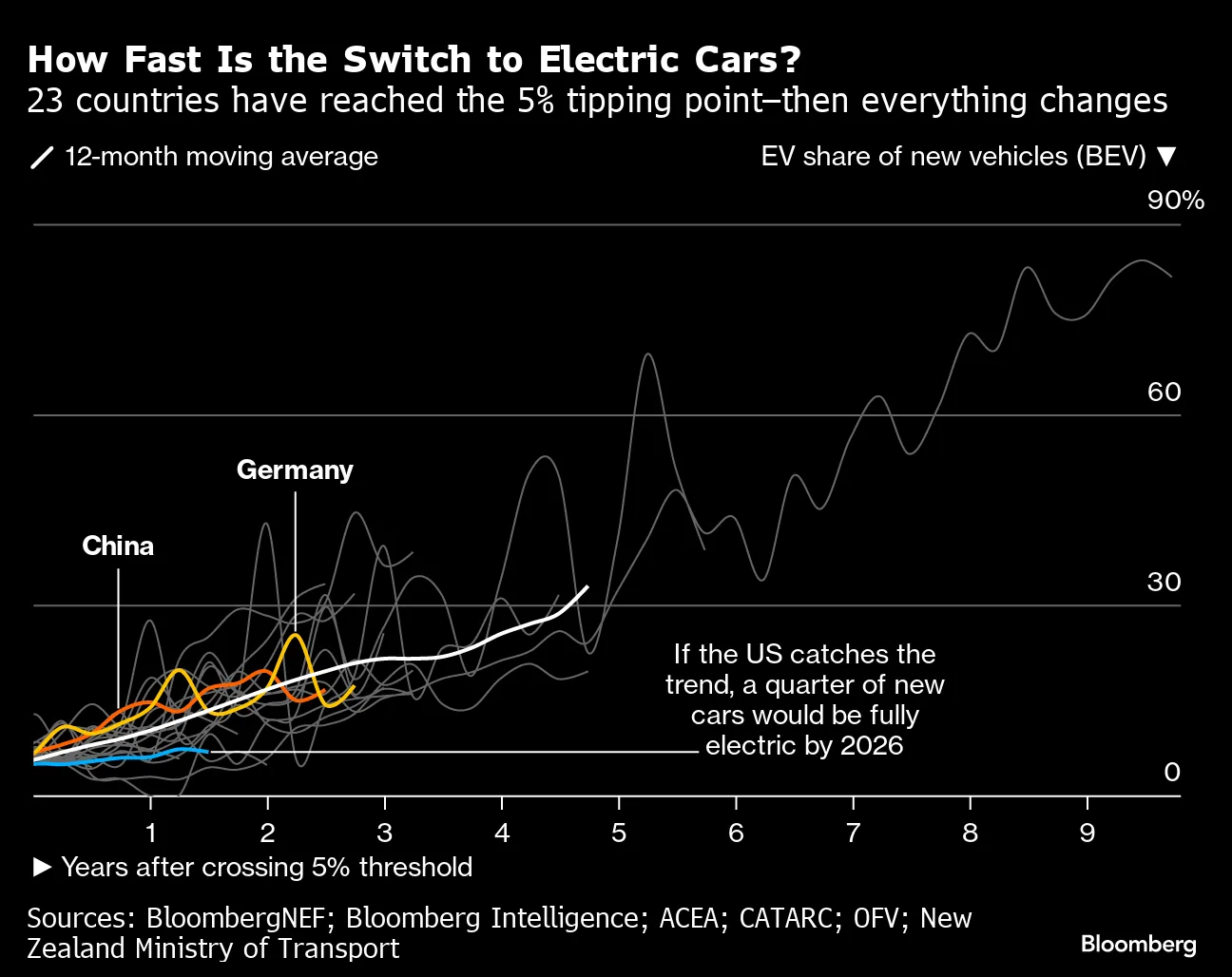
Based on historical data, this 5% electric vehicle sales threshold marks a critical juncture in the adoption of new technology - a similar S-shaped curve is seen when other new technologies were in early stages of adoption such as smartphones, LED bulbs etc. Essentially this S-shaped curve means that there is a shift from early adopters to mass mainstream consumer acceptance for this new technology.
Although a significant leap in EV sales growth and EV adoption has been witnessed, particularly in the US, China, and Europe, which collectively account for 90% of global EV sales, a substantial segment of the global market remains untapped. 4 of 20 most populous countries have crossed the critical EV tipping point, highlighting that a majority of the global automotive market has yet to fully embrace EVs.
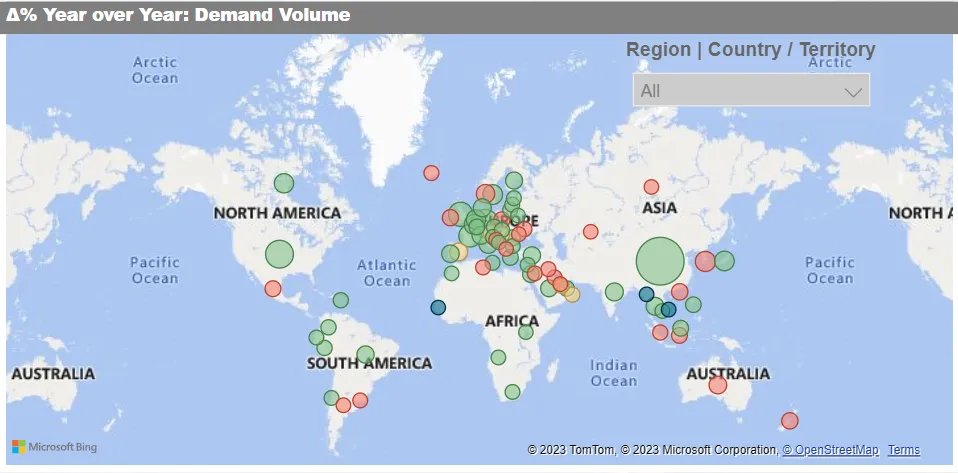
While sales of new internal combustion engine vehicles had peaked in 2017, with net growth in car sales now being propelled by EVs, projections, such as those from BloombergNEF, indicate a decline of gas-powered vehicles. Globally, the EV tipping point was attained in 2021. Now, whether transitioning to EVs takes a decade or five depends on many factors, but demand volume for EVs has stayed strong for September 2023.
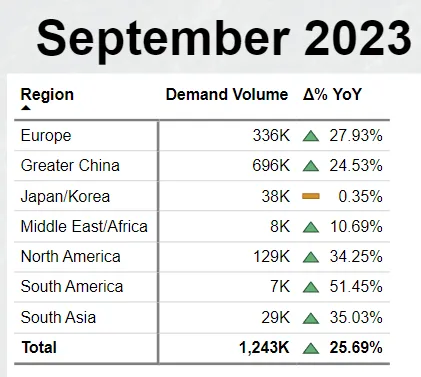
Historical data affirms that once the EV threshold is crossed, median sales growth of 55% was observed in the last quarter when compared to previous year. This EV growth rate does taper as the market saturates e.g. Norway saw EV and hybrid car sales at around 80% and has stabilized around it. And what we see is that as the electric vehicle market has evolved, early adopter countries such as Norway and other European countries saw consumers purchasing hybrid vehicles — vehicles with both batteries and gasoline-powered engines. There are 19 countries when we look at both electric vehicles and hybrids, that have crossed a 10% threshold for new vehicle shares. However, many other countries like China, US, India have completely bypassed adoption of hybrids and have opted directly for electric vehicles.
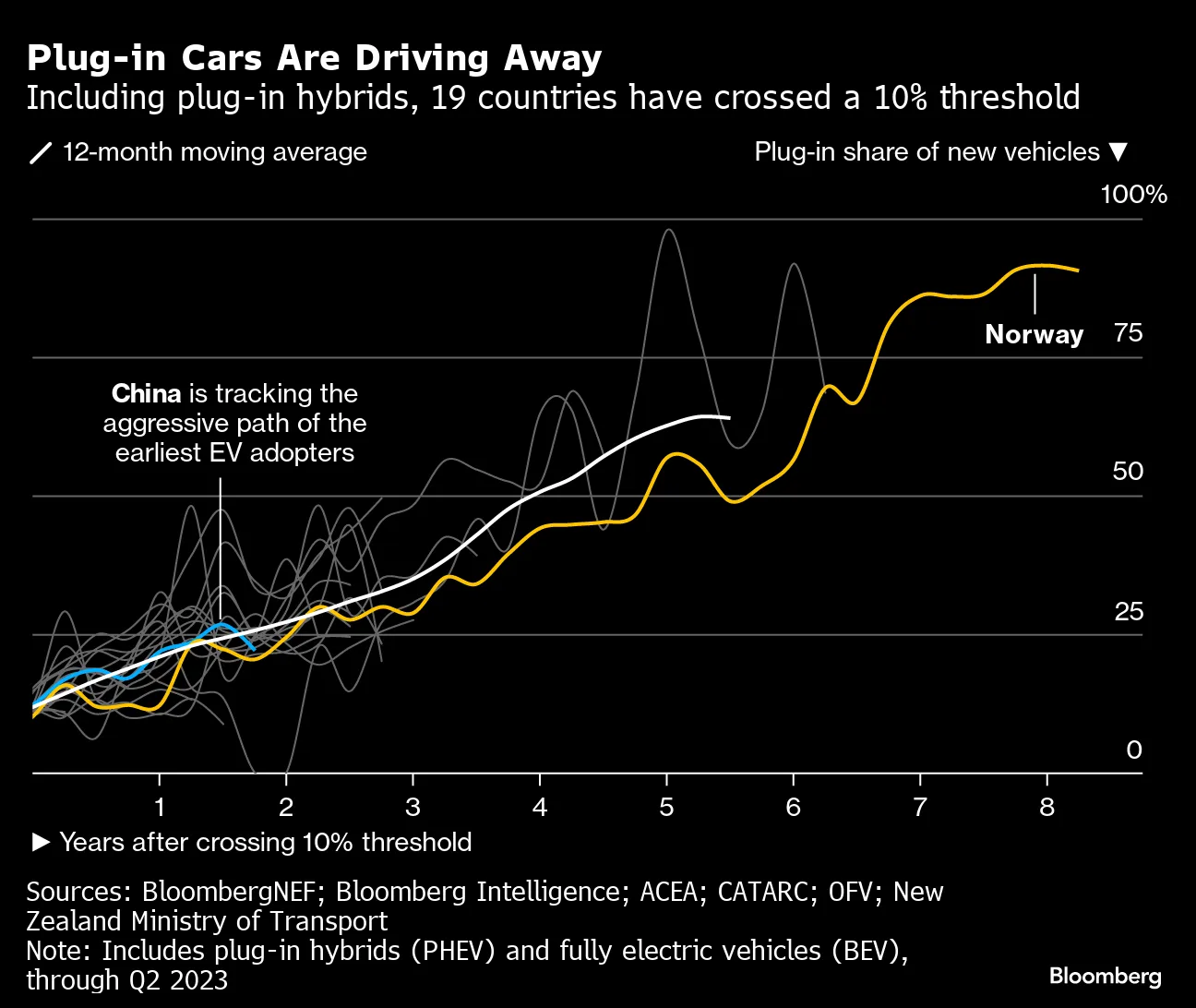
Global sales of plug-in vehicles, combining fully electric and hybrid models, exceeded 10 million last year, and BloombergNEF anticipates that this figure might triple by 2027. However, because hybrids don’t necessitate the same infrastructural and consumer investments as fully electric vehicles, their adoption can exhibit a more unpredictable pattern, occasionally yielding transient surges without indicating a fundamental shift in consumer buying patterns.
A reliable tipping point for this combined EV category, encompassing hybrids and fully electric vehicles, materialized when 10% of new vehicles sold were under this umbrella. When this threshold is crossed, the nation typically witnesses mainstream adoption of plug-in vehicles. Countries like the U.S., Australia, and Canada have flirted with this 10% tipping point recently, with hybrid sales in the U.S. potentially set to escalate owing to recently implemented incentives.
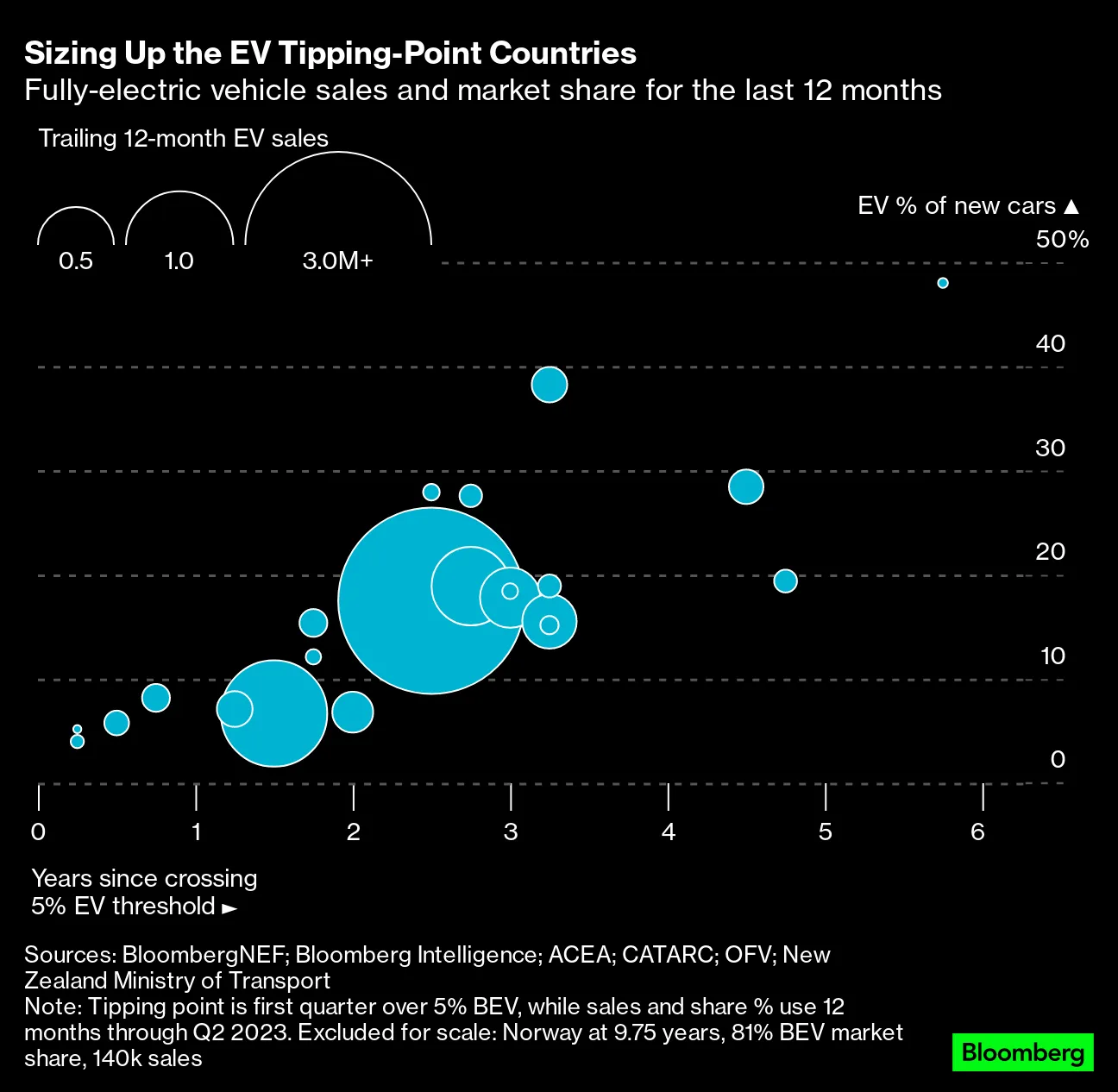
Governments are also coming up with regulation for EVs, spending money on building an EV ecosystem, charging infrastructure and boosting domestic production, specifically when we consider the larger demand nations. For instance,
US is pushing for EVs and hybrids to be 50% of all new vehicle sales by 2030.
Legislative actions, such as the 2021 Bipartisan Infrastructure Law and the 2022 Inflation Reduction Act, are funnelling substantial investments into various aspects of EV infrastructure, including charging networks and battery recycling plants.
India is removing diesel vehicles by 2030
India will have electric vehicles as 100% of new sales by 2030
Whether these lofty goals will be achieved or effective implementation and impacts of these policies will be achieved is to be seen. There are a few challenges for mass adoption
Potential inability of getting consistent supply of minerals critical for manufacturing batteries such as lithium, cobalt, and nickel.
Sustainability of material supply chains, impacted by geopolitical, environmental, and economic factors.
Cost remains an important factor, as the industry grows lower cost products will enter the market. But will it be dominated by 1 country like China, pumping in through subsidies or will it prosper on the back of many companies across geographies
And from a sustainability perspective, how durable are EVs being manufactured? Are the byproducts also green ? What happens to batteries when they are disposed of?
Traditional automobile manufacturers also face an uphill battle in these early adopter countries - challenge of preemptively investing in EVs before demand fully materialises.
Substantial reconfigurations in manufacturing facilities and supply chains and holistic redesigning of vehicles with electrification at the forefront
Tesla nearly went bankrupt to manufacturer its Model 3 in 2017 but strategically scaled production past 5,000 cars per week at which point the company felt a positive cycle of lower costs, higher volumes and economies of scale take effect
This brings us to the next tipping point, specifically for electric vehicle manufacturers when EVs are 10% of their quarterly sales. European data shows that this increases 3x in under 2 years. In the graph below, we can see BMW, Volkswagen, Volvo and other saw their new EV sales increase manifolds within a first 2 years. Volvo saw a massive increase within just the 1st year and this speaks to the company’s focus on eliminating combustion engines and hybrids from its car lineup by 2030.
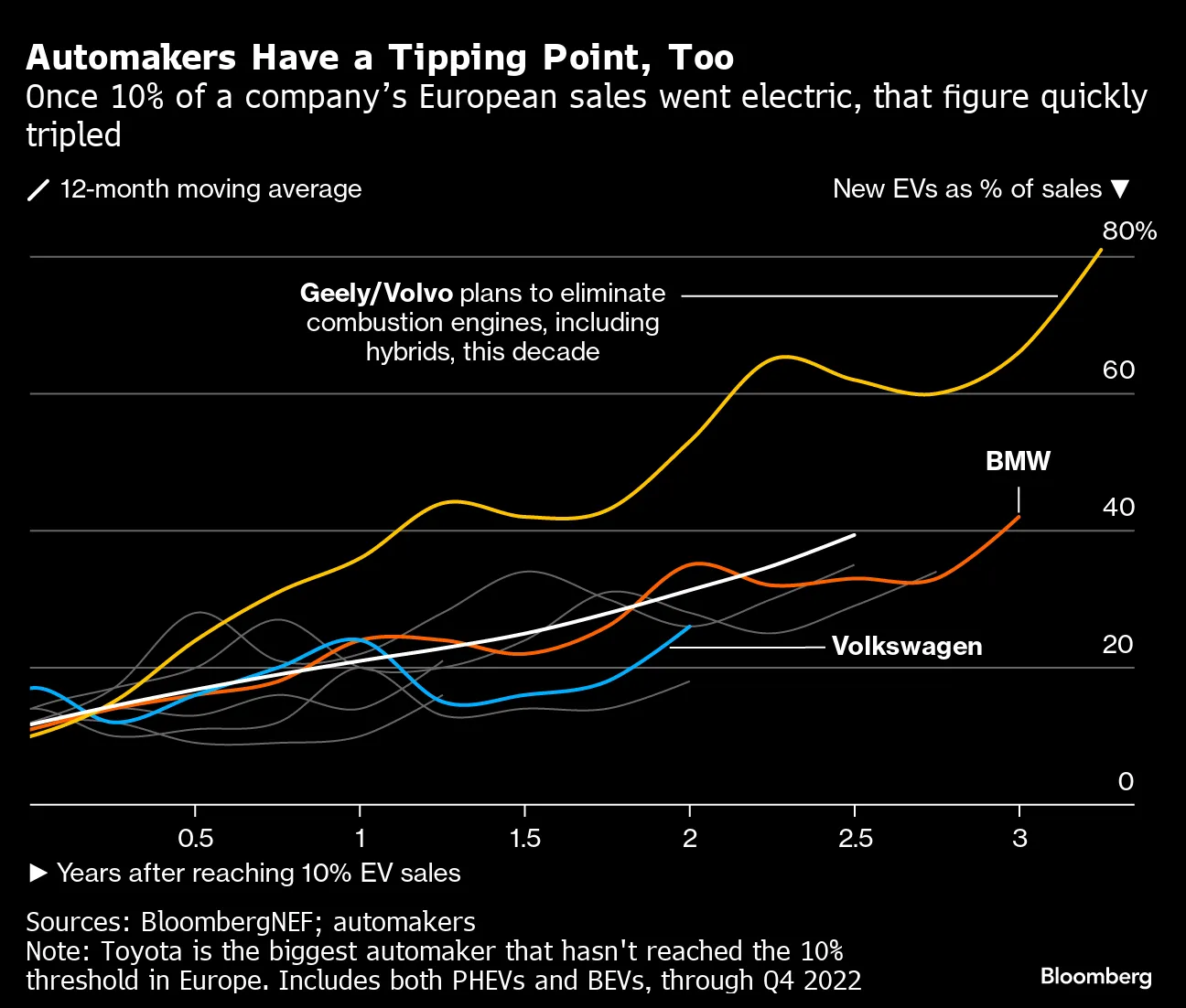
Tesla, Rivian and many others have led the electric vehicle adoption and sales not just for retail consumers but also for commercial use cases. In late 2021, the US crossed this 5% new electric vehicle sales threshold. This was significantly delayed due to various challenges such as consumer preference for longer driving range which was lacking in early electric vehicle models, dominance of hard-to-electrify large SUVs and pickup trucks in the marketplace. However, with a 42% increase in US EV sales in Q2 compared to the same period the previous year, and upcoming releases from major automakers like Tesla, Chevy, Ford, and Ram, an accelerated adoption trajectory is anticipated.
China's electric vehicle industry is booming and has been exporting like a madman, especially to Europe. This has put the industry in a pickle as the EU scrutinises these companies, their sales and whether unfair subsidies are impacting local domestic production of EVs and disadvantage European automakers. Subsidies have indeed been a linchpin of China's EV strategy such as through tax breaks to research & development support. Only a handful of the 167 China brands selling EVs are profitable, implying a potential misallocation or inefficiency in the subsidy expenditure. Of the 5 publicly listed Chinese EV makers, only 2 are currently above the break-even point.
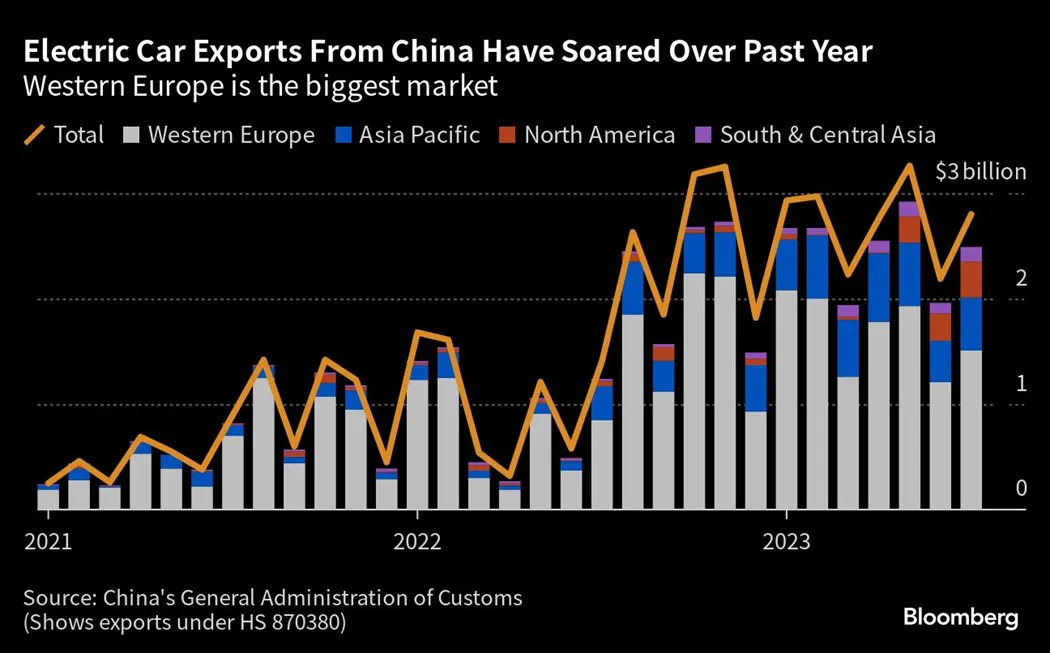
Almost all EVs sold in China enjoy exemption from vehicle purchase tax, a move to kindle consumer demand and hence, enhance revenues for automakers.
Tax exemption strategy is from 2009 till 2027, has alleviated around $30 billion in taxes and is expected to waive another $97 billion by 2027.
EV manufacturers, classified as high-tech companies, benefit from a reduced corporate income tax rate of 15% compared to its standard 25%.
Car exports are immune from a 13% value-added tax.
Ministry of Industry and Information Technology incentivizes car companies with subsidies aligned with their EV production volume. These subsidies are nearly $5.4 billion.
R&D subsidies, often dispensed at the provincial or local level, include specific grants for vital technologies and the development of new-energy vehicles and pivotal components.
City of Hefei and related entities acquired a 24% stake in Nio in 2020 for 7 billion yuan.
Funds affiliated with the Hangzhou city government invested 3 billion yuan in Zhejiang LeapMotor Technologies in 2021.
Beijing has underwritten development of a nationwide charging infrastructure .
Commitment to subsidise public chargers to cater to over 20 million new-energy vehicles by 2025.
Through a merger of central government subsidies and local government directives, demand for EVs in public or state-controlled fleets has surged, providing a consistent revenue stream for manufacturers like BYD.
Increasing number of Chinese-made EVs exported to Europe, and the extensive subsidy structure in place, has resulted in the EU probing the fairness of these subsidies, potentially culminating in tariffs on exports of cars from Chinese automakers like BYD and even USA’s Tesla, which exports to Europe from its Shanghai giga factory. Speaking of Tesla and BYD, both reported strong EV sales selling 431,603 and 435,059 units respectively with a very narrow gap between the 2 companies. China’s BYD may soon become the bestselling EV company.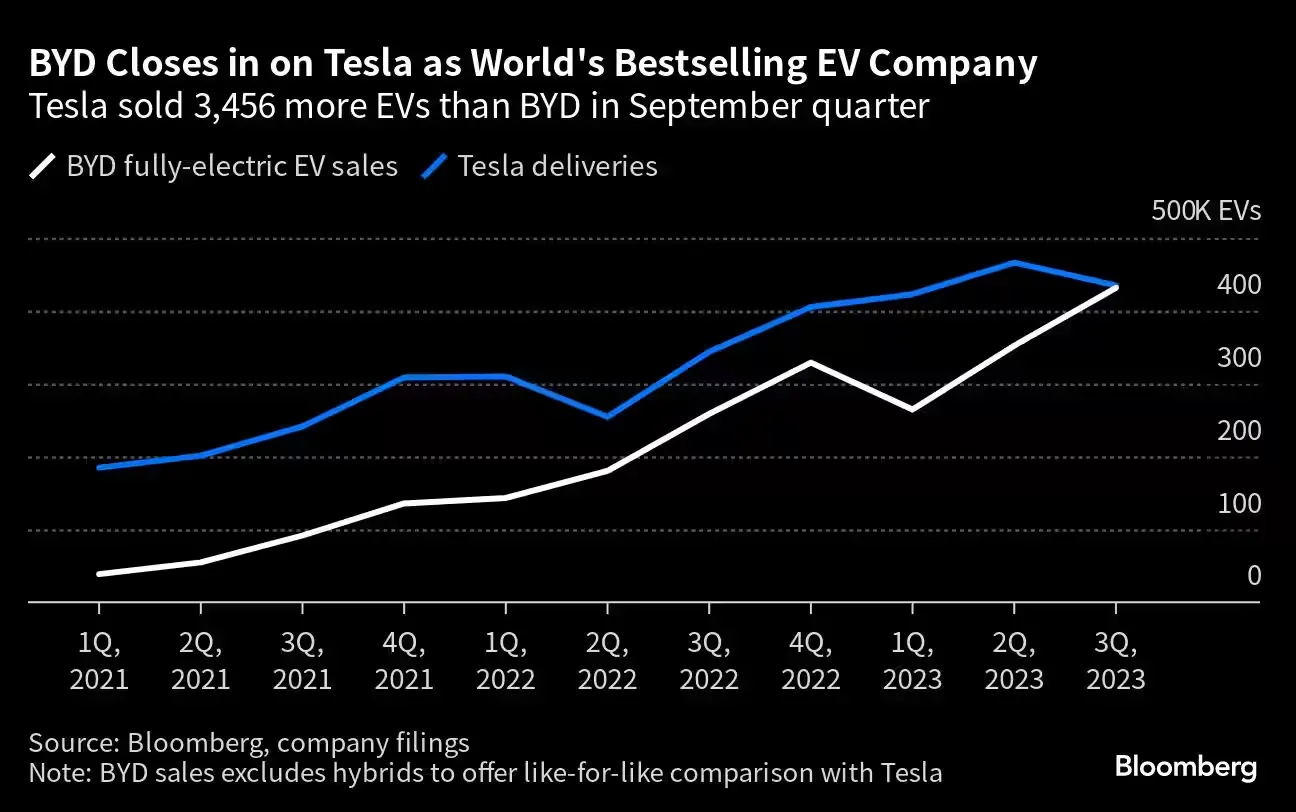
BYD's growing exports, which increased from 5% to 9% of their Q3 sales, and its self-sufficiency in battery and semiconductor chip production, are significant in enhancing its overseas market share. Despite missing delivery estimates by 20,000 units and amidst ongoing model updates, Tesla maintains its goal to sell 1.8 million vehicles annually, while BYD aims to sell about 3 million vehicles.
India is showcasing promising signs of becoming a pivotal player in the EV adoption landscape. Investments from domestic automakers like Tata Motors, Mahindra, Maruti, Ola, Ather, and even interest from Elon Musk to not just manufacture electric vehicles in India but also sale of Tesla shows a positive sentiment for India’s electric vehicle sector. The government has also made significant strides towards fostering an EV-friendly market in India. With its extensive automotive market not just in 4 Wheelers but in highly popular 2W and 3W segments along with commercial vehicles, India’s transition to EVs could be a critical juncture in global EV adoption. Let’s look at the current EV market in India in depth-
838,766 units sold in the initial 7 months of CY2023, representing 82% of the previous annual record of 10,24,806 units in CY2022.
A governmental vow to build a formidable EV fleet by 2030 is catalysing this upward trajectory.
In Q1 FY24, EVs accounted for 3% of new car sales, a statistic that doubled in just a half-year span.
Electric 2 and 3 wheelers have driven sales in the first half of CY 2023, with 2 wheelers at 58% and 3 wheelers at 36% of the EV market share.
Conversely, electric cars and SUVs have a mere 5.5% market share with 46,163 units sold.
National Electric Mobility Mission Plan 2020 (NEMMP) and FAME (Faster Adoption and Manufacturing of Hybrid and Electric Vehicles) I, II & III have provided subsidies and a roadmap to catalyse India’s transition towards electric mobility
Several state-level incentives and mandates are running such as subsidies for electricity tariff, waivers in road tax and stamp duty, SGST refunds, and offering direct per KWHr incentives for EVs
Proactive initiatives to facilitate EV manufacturing and charging infrastructure, such as offering land, capital subsidies, and supporting ancillaries and OEMs for integrated setups, substantiate the broader vision of an encompassing EV ecosystem.
India joining the MSP accentuates will help in securing critical minerals vital for battery production, ensuring reduced import reliance, boosting local manufacturing and solidifying its positioning in the EV sector.
State & Central governments are also addressing end-of-life processing and recycling for EV components, like Li-Ion batteries, and granting R&D funds for indigenous technology and innovation, showcases a sustainable and self-reliant approach towards the EV sector.
In April 2018 EV charging infrastructure benefited from policy support, as the charging set-up was deregulated from licensing requirements.
9,113 public charging stations with 15,493 chargers are operational as of July 31
Additional 22,000 expected by December 2024
EVs will help expedite achieving India's carbon reduction targets: 45% reduction in the economy’s carbon intensity by 2030, and net-zero emissions by 2070. Nitin Gadkari, Minister of Road Transport and Highways, expressed his desire to position India as a dominant player in the global automobile market. The unrelenting surge in EV sales, crossing the 100,000-unit mark consistently for 12 months straight since October 2022, was seemingly undeterred even by a 25% slash in the FAME subsidy on e-two-wheelers in June.
Growing incentives provided by the Indian government for EVs especially when compared to the tapering of incentives in regions like China, the UK, and Europe.
In FY23, EVs represented approximately 1% of the passenger vehicle market, and about 5% in electric two-wheelers.
In H1 FY2024 alone, the EV market experienced a 51% YoY sales increase, attaining almost 740,000 units.

Government aims to boost these figures to 30% for private cars and a staggering 80% for 2 wheelers by 2030.
A robust 158,381 units were sold in May 2023, as buyers sought to avail the incentives before the subsidy reduction.
Surprisingly, even with a 56% MoM plunge in e-two-wheeler sales post-June, an impressive 225,035 units were still sold from June to end-September 2023, indicative of a resilient and maturing market.
Two- and three-wheelers are spearheading the EV transition, collectively representing 94% of total EV sales. Specifically, electric two-wheelers (397,399 units) commanded a 54% share of total EV sales, with three-wheelers (296,401 units) accounting for 40% in H1 FY2024. despite the government slicing the subsidy from ₹15,000/kWh to ₹10,000/kWh in May.
There is a marginal increase in overall sales to 57,824 units, up from the last month's 56,961.
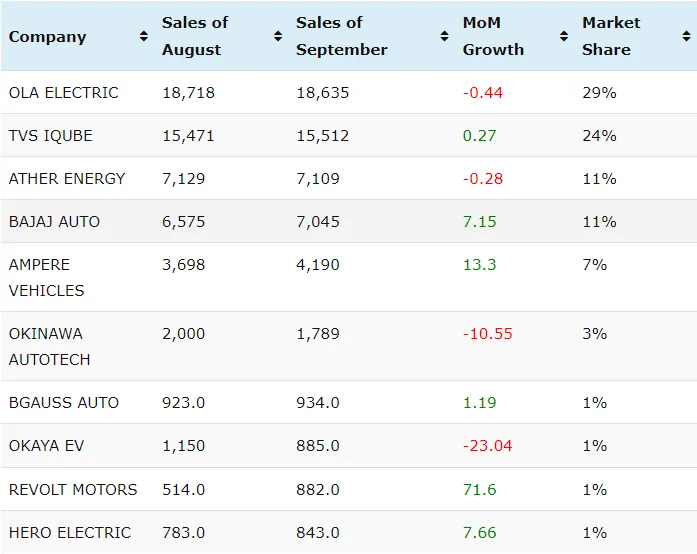
Ola, Ather, and Okinawa saw challenges in September.
Sales stumbled due to supply chain troubles that considerably impacted production and delivery timelines.
Ongoing global semiconductor shortage & a scarcity of essential components is hampering manufacturing schedules.
TVS, Bajaj, Ampere, Hero, and Revolt saw strong sales.
Ingenious marketing strategies attracted consumer attention and bolstered sales.
Established trust in brands like Bajaj and Hero amongst various demographics which has cushioned them against market volatility.
Robust dealer network ensured widespread accessibility and availability to consumers.
In the 3 Wheeler segment, Mahindra and Mahindra led, followed by YC Electric, Saera Electric, Dilli Electric, and Piaggio. Three-wheelers have become a pivotal part of India's micro-mobility landscape, often serving as last-mile connectivity solutions especially for commercial operations.
Although electric cars constituted a smaller chunk at 5% of total sales. There was active participation from renowned automakers. Tata Motors led with 12,491 units, followed by MG Motors, Mahindra, Hyundai, and BYD. Let’s look at 2 of the players in depth
Maruti Suzuki, the country's largest carmaker, predicts that 15% of its total sales will stem from EVs by FY31.
Breakdown of anticipated sales includes 25% from hybrids and 60% from vehicles powered by alternate fuels such as CNG, biogas, flex-fuels, and ethanol-blended fuels.
Relying on the 5% electric vehicle sales threshold described above, Maruti Suzuuki also expects India to see an accelerated rate of EV adoption from 2025 as India starts approaching 3-4% penetration
It is planning to launch its first EV in the mid-sized SUV segment in 2025.
Tata Motors saw a dip in passenger vehicle sales in August of 3% and September of 5%, but EV sales are doing well.
EV sales in H1 of FY2024 are 37,961 EV units, a 77% YoY growth.
Predictions suggest that Tata Motors will sell an additional 45,000-50,000 EVs in the latter half of FY2024, potentially hitting an 85,000-unit milestone for the full year
It has pledged an investment of US$ 2 billion over 5 years starting in 2022 and aims to launch 10 EVs by 2026
To safeguard its future manufacturing capabilities, Tata Motors recently acquired Ford India’s plant in Gujarat. Additional production capacity of 300,000 units per annum, expandable to 420,000 units.
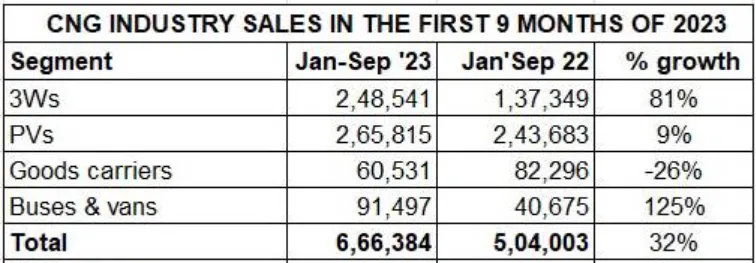
India’s EV sector has surmounted hurdles posed by challenges like limited charging infrastructure and high upfront EV costs (largely attributable to battery prices). With steady progress and at the existing double-digit growth rate, reaching the 1.5 million unit sales mark in FY2024 seems plausible, translating to a commendable 27% YoY growth against FY2023's 11,83,166 EVs sold. This benchmark would significantly propel EVs from their current 5.30% share of the total India auto market (based on FY2023’s 22.31 million automobiles sold across various fuel types).
To achieve this 1.5 million sales landmark for FY2024, approximately 760,000 more EVs would need to find buyers from October 2023 to March 2024. Hitting this ambitious target seems within reach when we look at the boost expected from the upcoming festive season. Parallel development in EV charging infrastructure and continual focus on localisation by OEMs to reduce costs and enhance affordability, underscores a pivotal shift in India's vehicular landscape. Especially as battery prices are anticipated to gradually decline, a surge in demand across EV segments is expected to follow.
EV policy, inaugurated for three years in August 2020 and recently extended for an additional six months as its revision is pending, set an ambitious goal: 5 lakh new e-vehicle registrations in five years and having 25% of new vehicles sold be electric by 2025.
Consumer trends are showing that there is a growing appetite for newer models and EV variants, while enthusiasm for diesel vehicles is diminishing.
Delhi witnessed a 20% boost in electric vehicle (EV) sales during the initial 6 months of the current fiscal year, compared to the analogous period in FY 2022-23.
Diesel vehicle sales plummeted by over 24% between April and September of this year compared to the same span in the preceding fiscal.
Purchases of EVs were 32,400 units until September 30, 2023 v/s 26,936 units last year.
Diesel cars saw a decline in registrations, falling from 8,393 last year to 6,344 this year during the aforementioned period.
Approximately 11% of total vehicle registrations in Delhi between April and September of this year were electric.
New vehicle sales are typically higher in the second fiscal half due to the festive season, appealing schemes, and discounts
With a competitive EV manufacturing ecosystem that marries quality with affordability, India is strategically positioned. In H1 FY24, India’s EV export market grew 246.3%, with significant interest from Nepal & Europe.
Rs 7,988.62 lakhs of EV exports in 2022 to an impressive Rs 21,391.40 lakhs in 2023. However, June did see a sharp 74.75% decline.
Nepal, France and Germany had high Indian EV imports.
China and the UK had a consistent appetite for Indian EVs, albeit with fluctuations in quantities.
Vietnam, Brazil, Guatemala, and Australia also imported Indian EVs
Maldives, US, Canada, New Zealand, and Portugal haven’t imported anything substantial this year
An upcoming festive season which has traditionally seen an uptick in vehicle purchases, could see similar impact on EV sales in India. Large automotive companies are doing new EV announcements. However, in this nascent growing sector adaptability of these companies is important, especially for smaller and newer players. Ongoing global challenges, particularly around component availability, necessitate strategic foresight and planning to mitigate impactful disruptions.
Read the full article on Wright Research Indian Electric Vehicle Sector Booming: EVs Tipping Point.
Join our Telegram Channel to get daily morning market updates. Subscribe to our Youtube Channel to learn about all things investing, understand sector performance, get key insights into new topics like concentrated portfolio, quantitative investing and more!
We are conducting a Live Stream this Sunday at 11:30 AM to talk about Market Volatility , Market Corrections , Rebalancing Strategy, Portfolios and a Live AMA (Ask Me Anything). Want to submit questions? Drop them here
Discover investment portfolios that are designed for maximum returns at low risk.
Learn how we choose the right asset mix for your risk profile across all market conditions.
Get weekly market insights and facts right in your inbox
It depicts the actual and verifiable returns generated by the portfolios of SEBI registered entities. Live performance does not include any backtested data or claim and does not guarantee future returns.
By proceeding, you understand that investments are subjected to market risks and agree that returns shown on the platform were not used as an advertisement or promotion to influence your investment decisions.
"I was drawn to Wright Research due to its multi-factor approach. Their Balanced MFT is an excellent product."

By Prashant Sharma
CTO, Zydus
By signing up, you agree to our Terms and Privacy Policy
"I was drawn to Wright Research due to its multi-factor approach. Their Balanced MFT is an excellent product."

By Prashant Sharma
CTO, Zydus
Skip Password
By signing up, you agree to our Terms and Privacy Policy
"I was drawn to Wright Research due to its multi-factor approach. Their Balanced MFT is an excellent product."

By Prashant Sharma
CTO, Zydus
"I was drawn to Wright Research due to its multi-factor approach. Their Balanced MFT is an excellent product."

By Prashant Sharma
CTO, Zydus
Log in with Password →
By logging in, you agree to our Terms and Privacy Policy
"I was drawn to Wright Research due to its multi-factor approach. Their Balanced MFT is an excellent product."

By Prashant Sharma
CTO, Zydus
Log in with OTP →
By logging in, you agree to our Terms and Privacy Policy
"I was drawn to Wright Research due to its multi-factor approach. Their Balanced MFT is an excellent product."

By Prashant Sharma
CTO, Zydus
Answer these questions to get a personalized portfolio or skip to see trending portfolios.
Answer these questions to get a personalized portfolio or skip to see trending portfolios.
(You can choose multiple options)
Answer these questions to get a personalized portfolio or skip to see trending portfolios.
Answer these questions to get a personalized portfolio or skip to see trending portfolios.
Answer these questions to get a personalized portfolio or skip to see trending portfolios.
(You can choose multiple options)
Investor Profile Score
We've tailored Portfolio Management services for your profile.
View Recommended Portfolios Restart